Sylvain Levier: ''Music makes images appear, images make forms emerge, and finally these forms can become tangible''
– Before we get to the series of artworks that you created as a visual complementarity of French composer Bruno Duplant's new solo work entitled Chance, please tell me about the progress and relevant stages that led you to what you are doing now as a graphic artist. I am interested in your formal or non-formal schools, influences or simply the milieu that shaped you as a visual artist.
Sylvain Levier: ''Nothing in my environment predestined me for the arts. As a child I had great difficulty in communicating, a fear of others and of the outside world, which led me to undergo child psychotherapy for seven years. A large part of this therapy was devoted to drawing and modelling. I realised that drawing could be another way of communicating which seemed to me easier than talking. This is still the case today, even if I have learned to tame my fears. The time of creation represents for me a space apart where I can somehow escape from reality. It is a decoy, but I need it.''
– You studied and graduated in wood sculpting, but now we are talking about purely graphic artworks. Can you recall when, how and maybe most importantly: why your focus shifted from one art form to another?
Sylvain Levier: ''Yes, I remember very well, I switched from one to the other when I finished my studies, for practical reasons as I no longer had a studio. Drawing allows me to work almost wherever I want and to materialise my ideas more quickly. I really hope to go back to sculpture one day, if I still have the strength, which is less certain. Life is too short to be a sculptor, three years was hardly enough time to become familiar with the material. That said, a strong knowledge of drawing is necessary to understand the volume.''
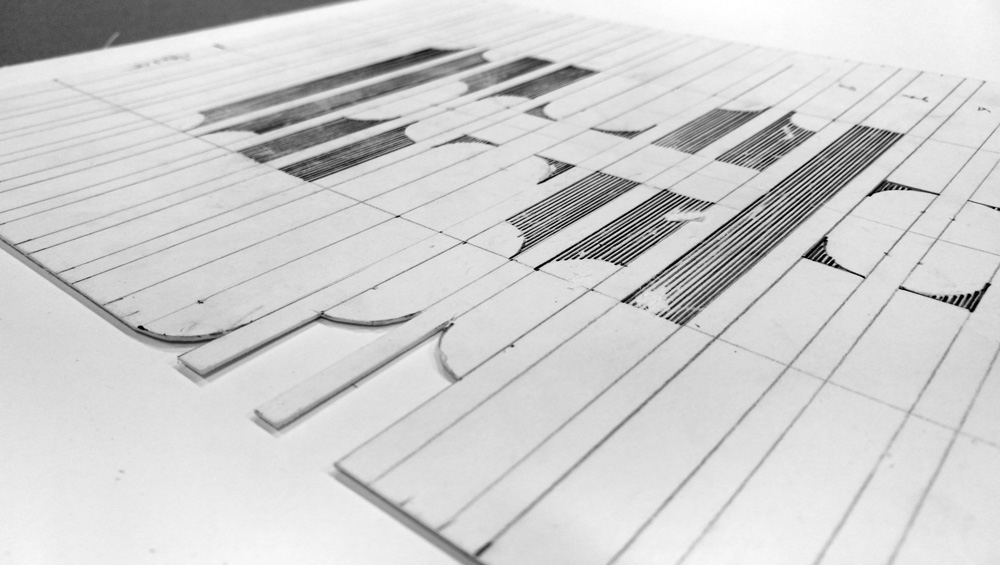
– Looking at your graphic works – especially at your drawings and illustrations – the tight constructions, the well-measured precision, the balance, the contrast all make me believe that architecture or composed music are not far from your interest. Do I guess right that your personal interest lies in the intersection of these disciplines?
Sylvain Levier: ''You are absolutely right. I am interested in the bridges and parallels that can be established between these disciplines. The temptation to get something hybrid, something at the crossroads is there. Most of my work can give the illusion of belonging to another field and seems to contain enough information to turn into something else, to have another purpose than a simple drawing. I always work while listening to music, because it brings out the emotions and feelings from the depths, it acts as a revealer when everything seems to be dead end. Music makes images appear, images make forms emerge, and finally these forms can become tangible. Both music and drawing are mental constructs, only the tools of expression are different and so are the senses involved. I can go a long time without feeling the need to draw but I can't do without music. Architecture is also a source of interest. The processes and developments that lead a simple idea, often just a few lines, into a concrete reality are fascinating. Today I don't enjoy drawing as much as I used to, but trying to represent the unknown is still very attractive and the end result is sometimes worth the effort.''
– The artwork for Bruno Duplant's Chance recording is not your first applied work that is created for a release cover or overall packaging. You had delivered graphics for Jürg Frey's l'air, l'instant album or for releases by Melaine Dalibert – all for Yuko Zama's highly prestigious Elsewhere record label. How did these connections come about?
Sylvain Levier: ''In fact, this is all quite new to me. I first came into contact with Melaine Dalibert after having the opportunity to listen to some of his compositions in relation to the work of artists such as Vera Molnár and François Morellet. The way in which these compositions developed in time corresponded very well to the time of the gesture in my practice. From then on, my curiosity pushed me to dive into and explore contemporary classical music. I remember, it was like discovering a new world for a jazz lover like me. At that time, Melaine was about to release his first album on the Elsewhere label. The meeting with Yuko Zama who runs the label was unexpected but natural. Yuko has a great visual sensitivity and I guess my work appealed to her. At the very beginning of the pandemic, she contacted me to see if I would agree to the use of two visuals for the release of two Melaine singles and finally for the cover project for l'air, l'instant by Jürg Frey. I felt like I belonged, that I was part of something that fit me, probably because it allows me to stay behind while being visible.''
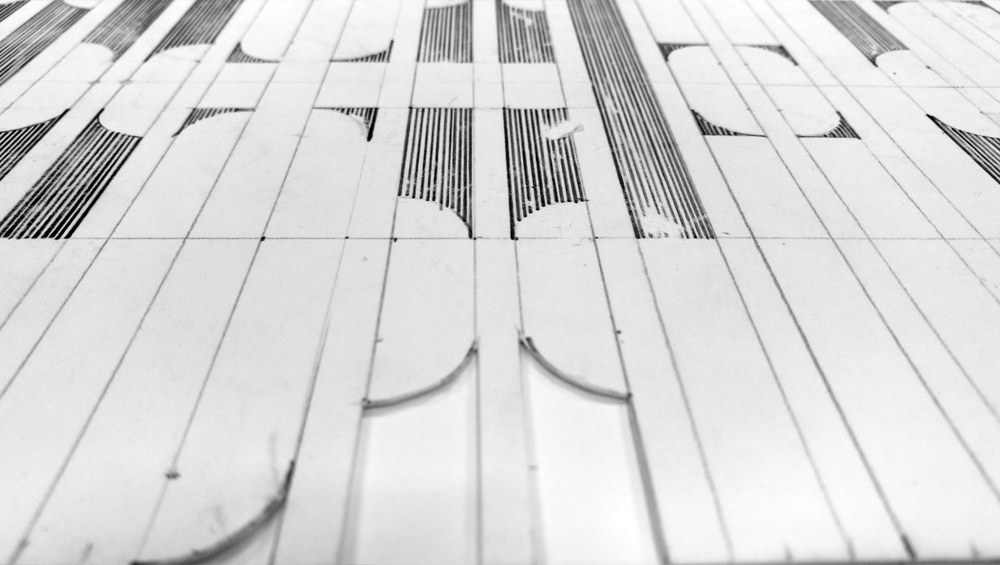
– Let's get to your particular artworks for Chance: after the composer had contacted you, how did your working process start? For release packaging artworks, are you getting inspiration from the music to create new graphics, or are you attaching existing ideas to the sounds you hear?
Sylvain Levier: ''Well, for my previous collaborations the visuals already existed and were chosen, I suppose, for their evocative power by Yuko Zama who kindly asked me if she could use them. It is totally different this time as I worked specifically for this project and got the inspiration from the music. Although my graphic vocabulary is recognisable, I wanted to achieve something unique with a strong visual impact that condemned the visuals and the music to cohabit. One of the essential guiding ideas was, at some point in the process, to experience the notion of chance, that there is something I can't control that I can't predict in advance. So first I made a library of shapes and randomly selected eight of them to represent the eight tracks of the recording. I first tried to assemble them in the order I had chosen them to obtain the cover that would serve as a basis for the next steps. I must admit I changed the order for compositional reasons. I then worked by superimposing the same visual in different directions until I exhausted the possibilities. The last and fourth visual of the limited edition is the last readable composition. I provoked it a bit, but luck was with me.''
– Now, when we are having this conversation, the album is still months away from its release date. I decided to make this interview now, because somehow I am more interested in the process, in the state of ''work in progress'', in the changes of ideas and approaches rather than in the final result. I remember your messages about starting everything over or changing directions, and I found, and still find your approach extremely devoted. Is this your usual approach of reaching the desired result, or is it an unusual situation?
Sylvain Levier: ''I always try to offer different options when I work with other people because I fully understand that my work can sometimes seem cold and a bit disturbing. In a collaboration, I think that all parties should be satisfied with the result, I am not alone, and even less in position to impose something. That said, there is a need to be flexible to a certain extent, both sides need to keep an open mind. Devotion is necessary because it brings patience, it is the only way to get a good grip on the subject, to dive into it. In a word, it has a strong influence on the result. I always work like this, the opposite would be simple execution. I always go to the end, in a somewhat obsessive way, there is a mental state to reach to get consistency.''
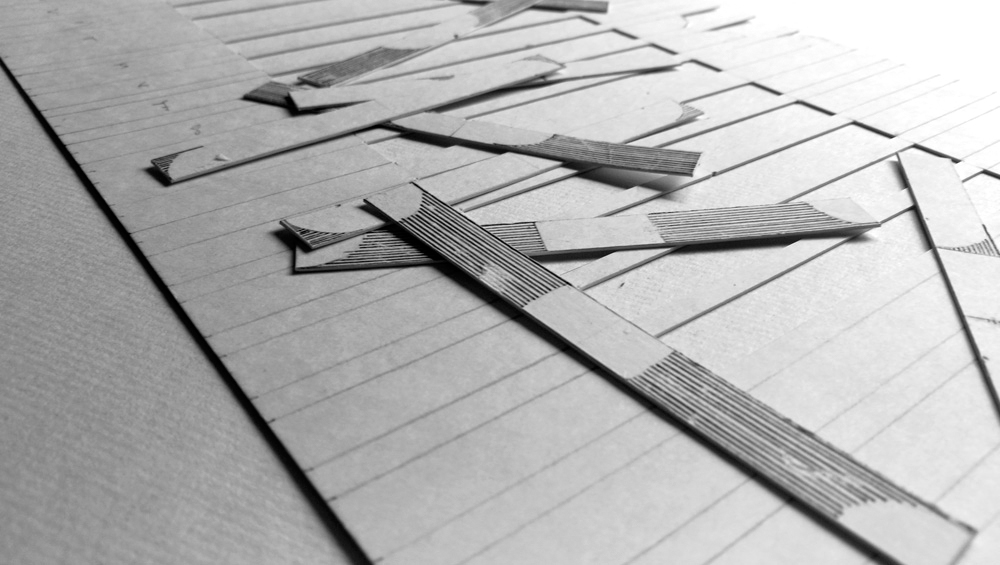
– We were discussing numerous possibilities regarding the packaging; how and where to display what, we were talking about cut-outs, six- or eight-panel digipacks and other practical options. In your opinion, when does a music release packaging work well when it comes to displaying artworks? What are your preferences as a visual artist, and what are your preferences as a music listener who holds a physical copy in his hands?
Sylvain Levier: ''I'll start by saying that I never buy music as a digital download, I remain very attached to the physical copy as a whole. The visuals allow the music to be embodied and are, in a way, a doorway into a world. On this subject, I too often have the impression that visuals, like texts, are there by default, like decoration, to fill in the blanks, which amounts to underestimating their evocative power and the emotional impact that an image can have. In the same way, I really think that a bad recording can still be unforgettable thanks to its cover. A cover that is forgotten is a failure. We had indeed first discussed the idea of eight visuals in connection with the eight tracks, but the result was not revealing enough with regard to the title and the content of the recording. I always had the impression that something was disturbing between the two instruments, which has appealed to me a lot in the good sense of the term. The result had to illustrate this feeling. That was the key. I think that drawing is particularly suited to contemporary classical, experimental and improvised music, which are more abstract than narrative, and in my opinion make shapes appear rather than tell stories. Most of the time photographs introduce a narrative, the drawing allows you to switch to something else. A music release packaging works well when a strange dialogue is established between the music and the image. My point of view is the same as an artist as well as a listener.''
– We decided to go with a six-panel digipack packaging which is displaying four artworks of yours on four of the panels. Is there a relationship between the artworks, are they communicating with each other, or are they telling an overall narrative? Is there a relevance in the order of the visuals when we are unfolding the packaging?
Sylvain Levier: ''Yes, there is a strong relationship between them because they are all obtained from the same cover image, they communicate with each other in a silent way. I worked step by step for the different compositions, each visual is derived from the one before it, so it is just a chronological order of work without any particular narrative. However, as I have mentoned, the last composition is the last possible state before the motif is no longer visible, so it is logical that this image is the last one.''
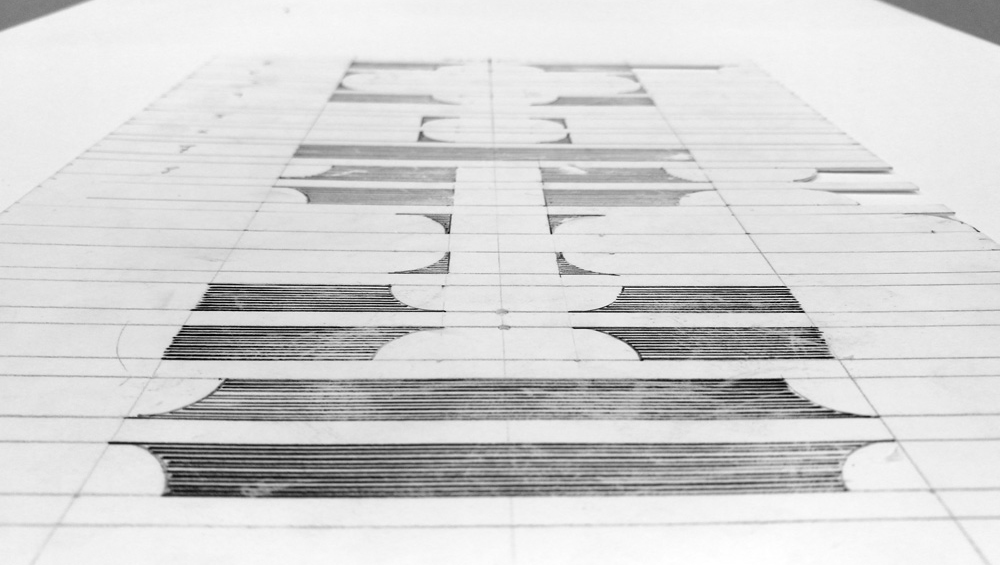
– Bruno Duplant's solo album is the first one in the catalogue of Inexhaustible Editions which is coming out also as a limited art edition with an original, signed and numbered artwork attached. What are your thoughts about connecting music releases with unique pieces of fine art works?
Sylvain Levier: ''It makes complete sense regarding your initiative. I immediately noticed the care taken with the visual aspect of your label's releases, even before Bruno contacted me. I am both surprised and proud to be the first to do so because I think your releases really lend themselves to the exercise. I'm sure that your audience is composed of kindred people, people open to all art forms, curious, and who appreciate the twisted paths. We have to keep in mind that it can't work every time, but I hope that this collaboration will make this publication even more attractive.''
– And in the end: your works definitely remind me of musical graphic scores, or graphical guidelines for something that could be eventually heard, or more precisely: could be listened to. Have you ever wondered what your graphics might sound like?
Sylvain Levier: ''The human mind always tries to hold on to something it can identify when it encounters the unknown. Finally, scores and plans are nothing more or less than drawings containing information. I have never asked myself this question, but now that you are asking me, I am even more curious about what the reverse process might look like. We just have to try it, asking Bruno would make sense. I'd be delighted.''
Sylvain Levier: ''Nothing in my environment predestined me for the arts. As a child I had great difficulty in communicating, a fear of others and of the outside world, which led me to undergo child psychotherapy for seven years. A large part of this therapy was devoted to drawing and modelling. I realised that drawing could be another way of communicating which seemed to me easier than talking. This is still the case today, even if I have learned to tame my fears. The time of creation represents for me a space apart where I can somehow escape from reality. It is a decoy, but I need it.''
– You studied and graduated in wood sculpting, but now we are talking about purely graphic artworks. Can you recall when, how and maybe most importantly: why your focus shifted from one art form to another?
Sylvain Levier: ''Yes, I remember very well, I switched from one to the other when I finished my studies, for practical reasons as I no longer had a studio. Drawing allows me to work almost wherever I want and to materialise my ideas more quickly. I really hope to go back to sculpture one day, if I still have the strength, which is less certain. Life is too short to be a sculptor, three years was hardly enough time to become familiar with the material. That said, a strong knowledge of drawing is necessary to understand the volume.''

– Looking at your graphic works – especially at your drawings and illustrations – the tight constructions, the well-measured precision, the balance, the contrast all make me believe that architecture or composed music are not far from your interest. Do I guess right that your personal interest lies in the intersection of these disciplines?
Sylvain Levier: ''You are absolutely right. I am interested in the bridges and parallels that can be established between these disciplines. The temptation to get something hybrid, something at the crossroads is there. Most of my work can give the illusion of belonging to another field and seems to contain enough information to turn into something else, to have another purpose than a simple drawing. I always work while listening to music, because it brings out the emotions and feelings from the depths, it acts as a revealer when everything seems to be dead end. Music makes images appear, images make forms emerge, and finally these forms can become tangible. Both music and drawing are mental constructs, only the tools of expression are different and so are the senses involved. I can go a long time without feeling the need to draw but I can't do without music. Architecture is also a source of interest. The processes and developments that lead a simple idea, often just a few lines, into a concrete reality are fascinating. Today I don't enjoy drawing as much as I used to, but trying to represent the unknown is still very attractive and the end result is sometimes worth the effort.''
– The artwork for Bruno Duplant's Chance recording is not your first applied work that is created for a release cover or overall packaging. You had delivered graphics for Jürg Frey's l'air, l'instant album or for releases by Melaine Dalibert – all for Yuko Zama's highly prestigious Elsewhere record label. How did these connections come about?
Sylvain Levier: ''In fact, this is all quite new to me. I first came into contact with Melaine Dalibert after having the opportunity to listen to some of his compositions in relation to the work of artists such as Vera Molnár and François Morellet. The way in which these compositions developed in time corresponded very well to the time of the gesture in my practice. From then on, my curiosity pushed me to dive into and explore contemporary classical music. I remember, it was like discovering a new world for a jazz lover like me. At that time, Melaine was about to release his first album on the Elsewhere label. The meeting with Yuko Zama who runs the label was unexpected but natural. Yuko has a great visual sensitivity and I guess my work appealed to her. At the very beginning of the pandemic, she contacted me to see if I would agree to the use of two visuals for the release of two Melaine singles and finally for the cover project for l'air, l'instant by Jürg Frey. I felt like I belonged, that I was part of something that fit me, probably because it allows me to stay behind while being visible.''

– Let's get to your particular artworks for Chance: after the composer had contacted you, how did your working process start? For release packaging artworks, are you getting inspiration from the music to create new graphics, or are you attaching existing ideas to the sounds you hear?
Sylvain Levier: ''Well, for my previous collaborations the visuals already existed and were chosen, I suppose, for their evocative power by Yuko Zama who kindly asked me if she could use them. It is totally different this time as I worked specifically for this project and got the inspiration from the music. Although my graphic vocabulary is recognisable, I wanted to achieve something unique with a strong visual impact that condemned the visuals and the music to cohabit. One of the essential guiding ideas was, at some point in the process, to experience the notion of chance, that there is something I can't control that I can't predict in advance. So first I made a library of shapes and randomly selected eight of them to represent the eight tracks of the recording. I first tried to assemble them in the order I had chosen them to obtain the cover that would serve as a basis for the next steps. I must admit I changed the order for compositional reasons. I then worked by superimposing the same visual in different directions until I exhausted the possibilities. The last and fourth visual of the limited edition is the last readable composition. I provoked it a bit, but luck was with me.''
– Now, when we are having this conversation, the album is still months away from its release date. I decided to make this interview now, because somehow I am more interested in the process, in the state of ''work in progress'', in the changes of ideas and approaches rather than in the final result. I remember your messages about starting everything over or changing directions, and I found, and still find your approach extremely devoted. Is this your usual approach of reaching the desired result, or is it an unusual situation?
Sylvain Levier: ''I always try to offer different options when I work with other people because I fully understand that my work can sometimes seem cold and a bit disturbing. In a collaboration, I think that all parties should be satisfied with the result, I am not alone, and even less in position to impose something. That said, there is a need to be flexible to a certain extent, both sides need to keep an open mind. Devotion is necessary because it brings patience, it is the only way to get a good grip on the subject, to dive into it. In a word, it has a strong influence on the result. I always work like this, the opposite would be simple execution. I always go to the end, in a somewhat obsessive way, there is a mental state to reach to get consistency.''

– We were discussing numerous possibilities regarding the packaging; how and where to display what, we were talking about cut-outs, six- or eight-panel digipacks and other practical options. In your opinion, when does a music release packaging work well when it comes to displaying artworks? What are your preferences as a visual artist, and what are your preferences as a music listener who holds a physical copy in his hands?
Sylvain Levier: ''I'll start by saying that I never buy music as a digital download, I remain very attached to the physical copy as a whole. The visuals allow the music to be embodied and are, in a way, a doorway into a world. On this subject, I too often have the impression that visuals, like texts, are there by default, like decoration, to fill in the blanks, which amounts to underestimating their evocative power and the emotional impact that an image can have. In the same way, I really think that a bad recording can still be unforgettable thanks to its cover. A cover that is forgotten is a failure. We had indeed first discussed the idea of eight visuals in connection with the eight tracks, but the result was not revealing enough with regard to the title and the content of the recording. I always had the impression that something was disturbing between the two instruments, which has appealed to me a lot in the good sense of the term. The result had to illustrate this feeling. That was the key. I think that drawing is particularly suited to contemporary classical, experimental and improvised music, which are more abstract than narrative, and in my opinion make shapes appear rather than tell stories. Most of the time photographs introduce a narrative, the drawing allows you to switch to something else. A music release packaging works well when a strange dialogue is established between the music and the image. My point of view is the same as an artist as well as a listener.''
– We decided to go with a six-panel digipack packaging which is displaying four artworks of yours on four of the panels. Is there a relationship between the artworks, are they communicating with each other, or are they telling an overall narrative? Is there a relevance in the order of the visuals when we are unfolding the packaging?
Sylvain Levier: ''Yes, there is a strong relationship between them because they are all obtained from the same cover image, they communicate with each other in a silent way. I worked step by step for the different compositions, each visual is derived from the one before it, so it is just a chronological order of work without any particular narrative. However, as I have mentoned, the last composition is the last possible state before the motif is no longer visible, so it is logical that this image is the last one.''

– Bruno Duplant's solo album is the first one in the catalogue of Inexhaustible Editions which is coming out also as a limited art edition with an original, signed and numbered artwork attached. What are your thoughts about connecting music releases with unique pieces of fine art works?
Sylvain Levier: ''It makes complete sense regarding your initiative. I immediately noticed the care taken with the visual aspect of your label's releases, even before Bruno contacted me. I am both surprised and proud to be the first to do so because I think your releases really lend themselves to the exercise. I'm sure that your audience is composed of kindred people, people open to all art forms, curious, and who appreciate the twisted paths. We have to keep in mind that it can't work every time, but I hope that this collaboration will make this publication even more attractive.''
– And in the end: your works definitely remind me of musical graphic scores, or graphical guidelines for something that could be eventually heard, or more precisely: could be listened to. Have you ever wondered what your graphics might sound like?
Sylvain Levier: ''The human mind always tries to hold on to something it can identify when it encounters the unknown. Finally, scores and plans are nothing more or less than drawings containing information. I have never asked myself this question, but now that you are asking me, I am even more curious about what the reverse process might look like. We just have to try it, asking Bruno would make sense. I'd be delighted.''
László Juhász
February 2022
Bagneux-based French graphic artist Sylvain Levier's current work focuses on the practice of drawing which is all about composition, the balance between emptiness and fullness, and what appears and disappears. The idea and illusion that the drawing could ultimately be the result of something other than the hand are at the center of his approach. Levier is currently working on the cover artwork for French composer Bruno Duplant's new solo release entitled Chance, to be released this Summer, and on its limited art editions with original, signed and numbered artworks attached. Ten questions and ten answers about his working ideas and methods regarding Duplant's music; about displaying artworks on release packagings; about limited art editions and about his drawings as possible graphic scores. Interview.
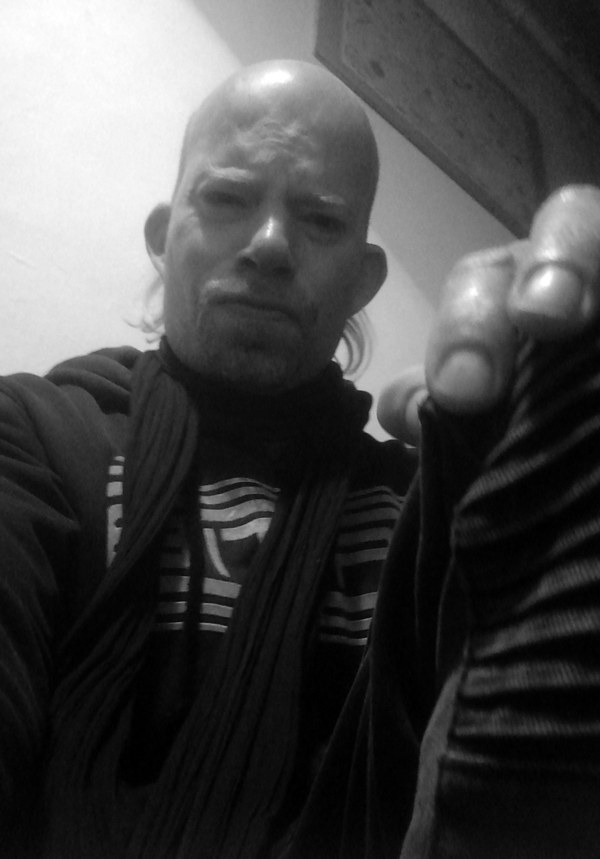
Photo by Sylvain Levier

Drawing by Sylvain Levier
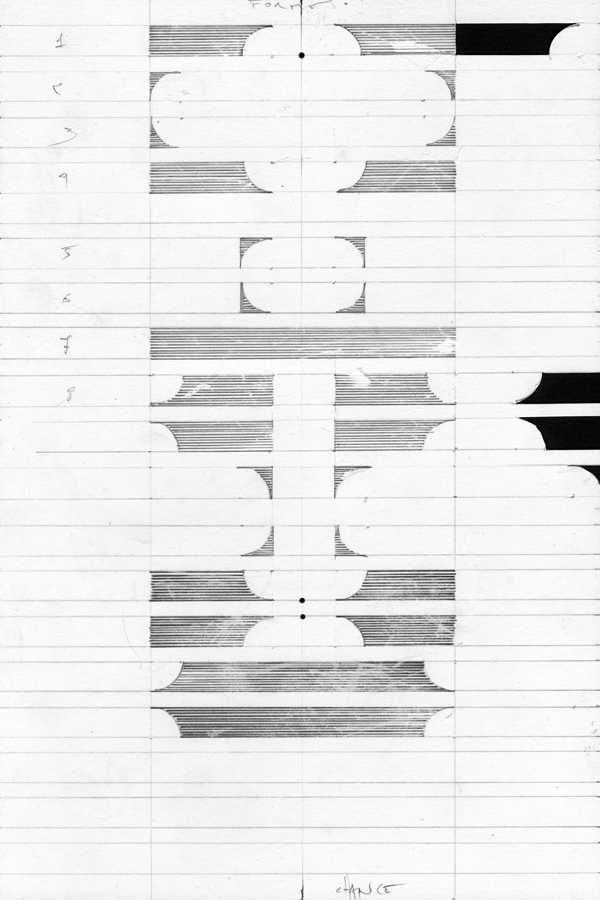
Drawing by Sylvain Levier
